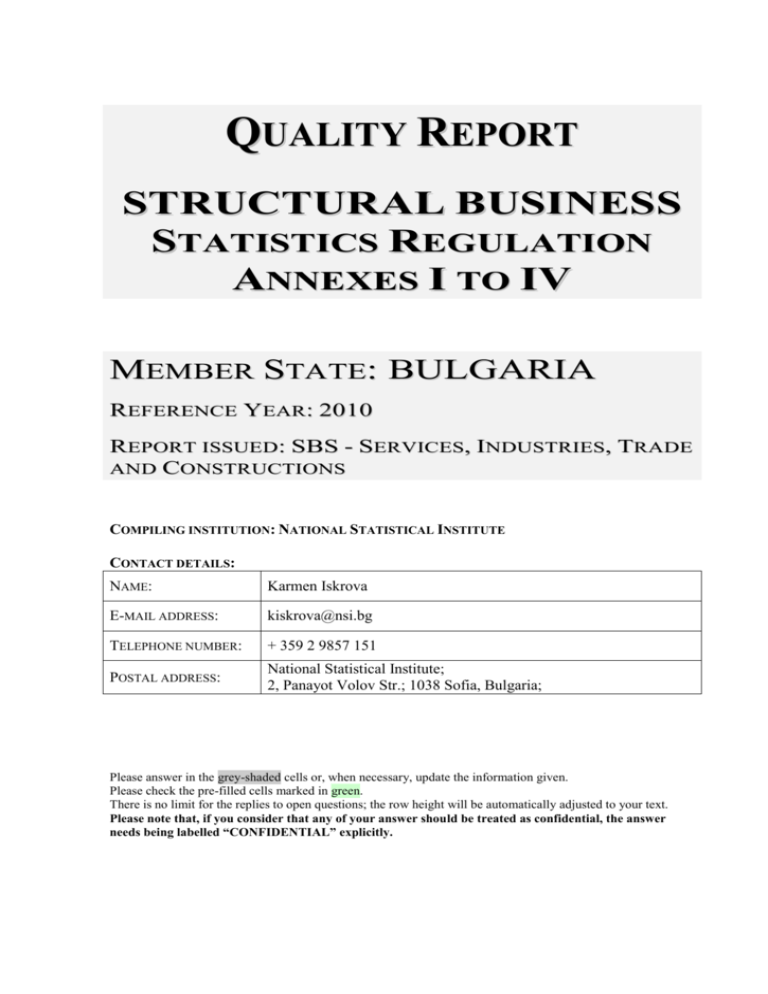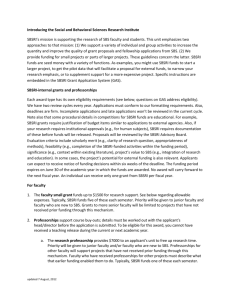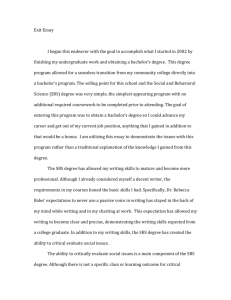Structural Business Statistics - Services, industries, trade and
advertisement

QUALITY REPORT S T R U C T U R A L B U SI N E S S STATISTICS REGULATION ANNEXES I TO IV MEMBER STATE: BULGARIA R E F E R E N C E Y E A R : 20 1 0 R E P O R T I S S U E D : S B S - S E R V I C E S, I N D U S T R I E S, T R A D E A N D C O N S T R U C TI O N S COMPILING INSTITUTION: NATIONAL STATISTICAL INSTITUTE CONTACT DETAILS: NAME: Karmen Iskrova E-MAIL ADDRESS: kiskrova@nsi.bg TELEPHONE NUMBER: + 359 2 9857 151 POSTAL ADDRESS: National Statistical Institute; 2, Panayot Volov Str.; 1038 Sofia, Bulgaria; Please answer in the grey-shaded cells or, when necessary, update the information given. Please check the pre-filled cells marked in green. There is no limit for the replies to open questions; the row height will be automatically adjusted to your text. Please note that, if you consider that any of your answer should be treated as confidential, the answer needs being labelled “CONFIDENTIAL” explicitly. Contact persons Annex I: RESPONSIBLE INSTITUTION: NATIONAL STATISTICAL INSTITUTE CONTACT DETAILS: NAME: Karmen Iskrova E-MAIL ADDRESS: kiskrova@nsi.bg TELEPHONE NUMBER: + 359 2 9857 151 Annex II: RESPONSIBLE INSTITUTION: NATIONAL STATISTICAL INSTITUTE CONTACT DETAILS: NAME: Karmen Iskrova E-MAIL ADDRESS: kiskrova@nsi.bg TELEPHONE NUMBER: + 359 2 9857 151 Annex III: RESPONSIBLE INSTITUTION: NATIONAL STATISTICAL INSTITUTE CONTACT DETAILS: NAME: Karmen Iskrova E-MAIL ADDRESS: kiskrova@nsi.bg TELEPHONE NUMBER: + 359 2 9857 151 Annex IV: RESPONSIBLE INSTITUTION: NATIONAL STATISTICAL INSTITUTE CONTACT DETAILS: NAME: Karmen Iskrova E-MAIL ADDRESS: kiskrova@nsi.bg TELEPHONE NUMBER: + 359 2 9857 151 2 Contents: CONTACT PERSONS .................................................................................................................................. 2 I. RELEVANCE .......................................................................................................................................... 5 I.1. COMPLETENESS ........................................................................................................................................ 5 I.1.1. DATA AVAILABILITY ............................................................................................................................... 5 THE AVAILABILITY RATE IS AS FOLLOWS (PRE-FILLED BY EUROSTAT): .......................................................... 5 I.1.2. AVAILABILITY OF CHARACTERISTICS AND/OR BREAKDOWNS REQUIRED BY THE SBS-REGULATION ... 6 I.1.3. USE OF THE QUALITY FLAG 'CONTRIBUTION TO EUROPEAN TOTALS ONLY' (CETO-FLAG) FORESEEN IN THE SBS REGULATION (FOR MORE EXPLANATION SEE ANNEX)....................................................................... 6 I.1.4. APPLICATION OF 1%-RULES FORESEEN IN THE SBS REGULATION ......................................................... 6 I.1.5. DEROGATIONS FROM THE PROVISIONS OF THE SBS REGULATION ......................................................... 7 I.2. CONFIDENTIALITY .................................................................................................................................... 7 I.3. MONITORING USER INTEREST ................................................................................................................. 8 I.3.1. DATA DISSEMINATION REPORT ............................................................................................................... 8 I.3.2. CONSULTATION OF YOUR MAIN USERS (TARGET GROUP: NARROW SCOPE, E.G. NATIONAL ACCOUNTS, CENTRAL BANKS, ECONOMY DEPARTMENT ETC.) ........................................................................................... 9 I.3.3. USERS' SATISFACTION (BROADER SCOPE) ............................................................................................. 10 II. ACCURACY AND RELIABILITY ...................................................................................................... 11 II.1. CONCEPTS AND SOURCES ..................................................................................................................... 11 II.2. NON-SAMPLING ERRORS ....................................................................................................................... 16 II.2.1. UNIT NON-RESPONSE ........................................................................................................................... 16 II.2.2. BIAS ..................................................................................................................................................... 17 II.2.3 IMPUTATION .......................................................................................................................................... 17 II.2.4 COVERAGE ERRORS............................................................................................................................... 18 II.2.5. PROCESSING ERRORS ........................................................................................................................... 19 II.3. INFERENCE (GROSSING UP) .................................................................................................................. 19 II.4. ASSESSMENT OF REVISIONS.................................................................................................................. 19 II.4.1. PRELIMINARY DATA VERSUS FINAL DATA ........................................................................................... 19 II.4.2. AVERAGE SIZE OF REVISION ................................................................................................................ 20 II.4.3. REVISION POLICY ................................................................................................................................. 21 III. COHERENCE AND COMPARABILITY....................................................................................... 21 III.1. COHERENCE ......................................................................................................................................... 21 III.2. COMPARABILITY ................................................................................................................................. 21 III.2.1. COMPARABILITY OVER TIME .............................................................................................................. 22 III.2.2. GEOGRAPHICAL COMPARABILITY: COVERAGE OF TARGET POPULATION .......................................... 22 III.2.3. GEOGRAPHICAL COMPARABILITY: OTHER ISSUES ............................................................................. 22 IV. TIMELINESS AND PUNCTUALITY ................................................................................................. 23 IV.1. TIMELINESS .......................................................................................................................................... 23 IV.2. PUNCTUALITY ...................................................................................................................................... 23 3 V. ACCESSIBILITY AND CLARITY ...................................................................................................... 25 V.1. ACCESSIBILITY ...................................................................................................................................... 25 V.2. CLARITY ............................................................................................................................................. 26 VI. FURTHER COMMENTS ..................................................................................................................... 26 ANNEX .......................................................................................... ERROR! BOOKMARK NOT DEFINED. 4 I. Relevance Definition Relevance is the degree to which statistical outputs meet current and potential user needs. It depends on whether all the statistics that are needed are produced and the extent to which concepts used (definitions, classifications etc.,) reflect user needs. I.1. Completeness The completeness is the extent to which data are available compared with the requirements in terms of characteristic, geographical and activity breakdown, as specified in the SBS Regulation 1. I.1.1. Data availability The availability rate is as follows (pre-filled by Eurostat): number of cells provided 100 number of fields applicable Availability rate 1A 1B 1C 1E 2A 2B 2C 2D 2H 2I 2J 2K 3A 3B 3C 3D 3E 3H 4A 4B 4C 4D TOTAL 1 BG 100 100 100 100 100 100 100 100 100 100 100 100 100 100 100 100 100 100 100 100 100 100 100 SBS Regulation: http://eur-lex.europa.eu/LexUriServ/LexUriServ.do?uri=OJ:L:2008:097:0013:0059:EN:PDF: 5 SPECIFICATION OF a) characteristics MISSING DETAIL: (TABLE TO BE FILLED IN BY EUROSTAT) nothing missing b) activities missing in series nothing missing c) breakdown in series nothing missing d) missing series nothing missing I.1.2. Availability of characteristics and/or breakdowns required by the SBS-Regulation Please comment on the rates of available statistics calculated by Eurostat and explain the reasons why any characteristics or breakdowns required by the SBS Regulation are not available (e.g. derogations) and describe your plans for improvement in the future. I.1.3. Use of the quality flag 'Contribution to European totals only' (CETO-flag) foreseen in the SBS regulation (For more explanation see annex) number of CETO - flagged cells 100 number of fields applicable CETO flags BG BG BG BG BG 2010 TOTAL 0 0 0 L1 L2 L3 L4 1A 1B 1C 1E 2A 2B 2C 2D 2H 2I 2J 2K 3A 3B 3C 3D 3E 3H 4A 4B 4C 4D 6 0 0 0 0 0 0 0 0 0 0 0 0 0 0 0 0 0 0 0 0 0 0 0 0 0 0 0 0 0 0 0 0 0 0 0 0 0 0 0 0 0 0 0 0 0 0 0 0 0 0 0 0 0 0 0 0 0 0 0 0 0 0 0 0 0 0 0 0 0 0 0 0 0 0 0 0 0 0 0 0 I.1.4. Application of 1%-rules foreseen in the SBS regulation Not applied. Please indicate whether you intend to provide in the next reference year any of the data for which you have applied the 1%-rule in the past. Please indicate whether you intend to discontinue the provision of the data for which the 1%rule could be applied (Eurostat will check the validity of this request and will confirm or not). I.1.5. Derogations from the provisions of the SBS Regulation Please indicate whether you intend to provide data for which you have granted derogation earlier than the timing foreseen in the SBS Regulation. I.2. Confidentiality I.2.1. The rate of confidential cells is as follows (pre-filled by Eurostat): Number of confidenti al cells 100 Number of cells provided Confidentiality rate BG BG BG BG BG 2010 TOTAL L1 L2 L3 L4 1A 11 0 3 13 13 1B 19 5 11 23 1C 3 0 4 1E* 0 2A 21 6 12 18 24 2B 21 0 14 24 2C 12 4 13 2D 13 0 5 9 15 2H 30 33 30 2I 30 42 29 2J 31 0 34 2K 38 17 40 3A 7 0 0 3 8 3B 10 0 0 12 3C 1 0 0 1 3D 17 0 0 20 3E 23 0 25 25 3H 12 0 0 22 7 4A 4B 4C 4D TOTAL 7 5 0 1 17 0 0 0 0 3 3 0 0 0 12 4 7 9 0 19 2 18 * Special aggregate series N.B. The number of confidential cells is calculated at the detailed level of the activity breakdown required by the Regulation (EC) 251/2009. I.2.2. Please describe your confidentiality rules (primary and secondary). Note: The described confidentiality rules will not be published by ESTAT. Two criteria (national confidentiality rules) are applied for primary confidentiality treatment that is carried out in NSI. They are specified in the Law on statistics, according to which aggregated statistics cannot be made public or released when: - the total of the information was received by less than three statistical units(Criterion A); - one enterprise formed equal or more than 85% in the total volume of aggregated data (Criterion B). Secondary confidentiality treatment is estimated by using the program CIF. In general, the cell with the smallest value is flagged with secondary confidentiality for the relevant aggregation and variable. The secondary confidentiality is checked and linked with data from the series of SBS. I.2.3. Have you taken any measures to reduce the number of confidential cell? [ ] Yes [X] No If yes, please describe them briefly: I.2.4. How do you evaluate the impact of the applied measured to reduce the number of confidential cells? very good good satisfactory poor very poor I.3. Monitoring user interest If the SBS data of Annexes I to IV are not disseminated at national level by your NSI, please answer only to the questions 1.3.2.5 and 1.3.3.3. I.3.1. Data dissemination report 1.3.1.1. Does the dissemination/publishing unit in your NSI keep track of the number of hardcopies of the SBS publications sent or sold?2 [ ] Yes 2 8 The ESTAT dissemination unit surveys the language policy in national publications: use of native language, use of English, use of any other language. This information is not specifically targeting SBS. If yes, how many publications were sent/sold from the most recent hard-copy publications (or in the last 12 months…): [ ] No [X] No (hardcopies are not printed) 1.3.1.2. Does the dissemination/publishing unit in your NSI keep track of the number of downloaded on-line SBS publications? [ ] Yes If yes, how many downloaded publications/data were sent/sold for the most recent SBS publications/data (or in the last 12 months…): [X] No [ ] No (publications are not available on-line) 1.3.1.3. Does the dissemination/publishing unit in your institute keep track of the number of downloaded data from the on-line databases? [ ] Yes If yes, how many downloads of SBS data were made last year: [ X ] No [ ] No (data are not available in on-line databases) 1.3.1.4. Do you or the dissemination/publishing unit in your NSI provide any information which is not available in the published publications and in the published on-line databases? [ ] Yes, to the public authorities [ ] Yes, to the public authorities and a limited set of registered main users [ X ] Yes, to everyone with a specific request [ ] No I.3.2. Consultation of your main users (target group: narrow scope, e.g. National Accounts, Central Banks, Economy department etc.) I.3.2.1. Has your unit regular consultations with some of your main users? [ X ] Yes [] No I.3.2.2. If yes, could you give a brief description of your main users and their needs (by main groups of users) Internal or external users? The main user of SBS data for annexes I-IV is the National accounts division at NSI. I.3.2.3. If SBS data of Annexes I to IV are published at national level, could you please give a brief description of the general opinion of the main users about the quality of the data? I.3.2.4. If SBS data of Annexes I to IV are published at national level, does the consultation with the key users reveal any specific unfulfilled need in addition to the requirements of the Annexes I to IV of the SBS Regulation? If yes, please specify. (Not to be filled in if questions 1.3.2.1 to 1.3.2.4 have been answered) I.3.2.5. If the SBS data as required for the Annexes I to IV of the SBS Regulation are not published as such at national level, would you please indicate why the data published by your NSI are more suitable for the users' needs? 9 I.3.3. Users' satisfaction (broader scope) I.3.3.1. Have you organised a punctual or a regular survey related to the users' satisfaction regarding the availability of your data for Annexes I to IV of the SBS Regulation in your country? [ ] Yes [ X ] No I.3.3.2. If you have organised a survey as such, to what extent the users' needs were fulfilled by the available data and if they are relevant for all of them? 10 II. Accuracy and reliability Definition Accuracy of statistical outputs in the general statistical sense is the degree of closeness of estimates to the true values. If a different methodology is applied for different activity groups (or by Annex of the SBS Regulation) this part of the quality report may be copied for each of the different methodologies. Please indicate clearly which activities or Annex of the SBS Regulation the information is referring to. II.1. Concepts and sources Member states may use different data collection systems to comply with the SBS regulation. It might be: the use of sample surveys3 (with administrative information present in the sampling frame and only used for stratification purpose), the use of a sample survey combined with use of administrative information (whereby this information is also used in the editing and imputation process and possibly in the inference process through calibration), the use of administrative data as the only source of information and all characteristics are calculated from the administrative records using or not a model based approach (in this case no survey information is used for a significant part of the strata covered). It is necessary only to fill in the concerned column. If several surveys are used in order to compile different SBS characteristics, the table should be copied as many times as there are survey. 3 Exhaustive interrogation of all enterprises is considered a type of survey. 11 Methodology 1: Sample survey II.1.1. Description of source a) Survey Methodology 2: Sample survey combined with administrative information The SBS survey for Annexes I-IV is exhaustive. 1. Please describe the sample design in particular: (If several surveys are organised to collect data, please describe separately, for each of them, the sample design). - - type of sample design stratified multistage clustered stratified multistage clustered Activity Employment size class Region Other (please specify Activity Employment size class Region Other (please specify stratification criteria - selection schemes (sampling rates) - any possible threshold values - the effective sample size - If the reference period differs from the calendar year is there a correction to bring it in accordance with the reference period? For SBS (calendar year). - Additional or specific information should be added in the column 'Methodology2 ' if the suggested options are not feasible with the used concepts in your country of compiling SBS data. ) ) Methodology 3: Administrative information b) Administrative source Please describe the administrative sources: The used administrative sources: - Please enumerate the characteristics directly available or with a good proxy in the administrative source. - Please enumerate the characteristics for which a model based estimate is used. - Is your unit able to check the plausibility of those data, namely by contacting directly the units? The extent to which the administrative source are used: - What kind of administrative data do you access? [ ] : data source, basic data for some characteristics [ ] : data source for imputation in case of non-response. [ ] : data source for imputation, for strata not covered by the survey [ ] : data source for 'mass imputation': (imputation of units not selected in the sample) [ ] : data source for calibration (calage sur marge) to optimize inference from survey results [ ] : micro data [ ] : aggregated data [ ] : for the entire population (global data) [ ] : by each (or some) economic breakdown class [ ] : for a part of the population (sole proprietor, companies, etc.) [ ] : other (please specify): ___________________________ [ ] : micro data [ ] : aggregated data [ ] : for the entire population (global data) [ ] : by each (or some) economic breakdown class [ ] : for a part of the population (sole proprietor, companies, etc.) [ ] : other (please specify): ___________________________ 13 How do you assess the frequency to which the used administrative data sources are updated? VG * Are the administrative data subject to several revisions with (increasing) degree of completeness? [ ] yes [ ] yes [ ] no [ ] no II.1.2.Relation between reporting units and the legal units / enterprise (statistical unit): Which is the relation between the reporting unit for the survey/administrative data and the enterprise? II.1.3. Definitions and concepts used in the survey/administrative sources : How would you assess the proximity of the definitions and concepts (including statistical units) used in the survey/administrative source with those required for statistical purposes? Please list the main differences between the survey/administrative source and the statistical definitions and concepts. Are there any of the SBS characteristics not included in those data sources? S P VP VG G S P VP The enterprise is reporting unit VG G S P VP VG G S P VP VG G S P VP yes If yes, please indicate the method used to compile those characteristics (estimation). yes If yes, please indicate the method used to compile those characteristics (estimation). yes If yes, please indicate the method used to compile those characteristics (estimation). ______________________________. ______________________________. ______________________________. no 14 G no no II.1.4. Sampling error: coefficients of variation Coefficients of Variation CV estimate of the sampling variance estimated value For the main series, by type of economic activity (1A, 2A, 3A and 4A – Regulation No 295/2008), a coefficient of variation for turnover (characteristics 12 11 0) is required on the NACE Rev2 – 3-digit (group) level. For the same series, coefficients of variation are expected for variables: 11 11 0, 12 11 0, 12 15 0, 13 31 0, 15 11 0 and 16 13 0 on NACE Rev.2 – Section level for the sections B, C, D, E, F, G, H, I, J, L, M and N and also on NACE Rev 2 – 2-digit (division) level for Div. 45, 46 and 47 covering the trade section and division 95. For the series broken down by employment size class (1B, 2B, 3B and 4B – Regulation No 295/2008) a coefficient of variation is required on NACE Rev 2 – 1-digit (section) level only for variables: 11 11 0, 12 11 0, 12 15 0 and 16 11 0. The size classes for which CV's are requested are those limited to the following set: 0–9, 10–19, 20– 49, 50–249 and 250+ persons employed for series 2B and 4B and 0-1, 2-9, 10-19, 20-49, 50-249, 250+ for series 1B and 3B.. Please provide in a separate file the coefficients of variation, according to the specifications from above, and describe the methods used and the aspects taken into account for computation of the CV (including software). Legend: VG= Very good; G=Good; Satisfactory= S; Poor=P; Very poor=VP 15 II.2. Non-sampling errors II.2.1. Unit non-response Unit non-response occurs when not all the reporting units in the sample participate in the survey or the needed information is not available in the administrative data sources. In principle non-responses can occur using both data sources: survey and administrative data. (If this is not applicable it should be explained why e.g. 'Administrative data have gone through an imputation procedure eliminating raw data flaws and imputing records not available.') II.2.1.1. Description of estimation methods for taking into account the unit non-responses a) Please describe the methods used for taking into account the unit non-response. The SBS survey is exhaustive but for some reasons a small number of enterprises have not submitted their annual reports. In this case, the data are obtained from other surveys (STS) or by estimation the results from the previous years. b) Please describe, when applicable, the measures taken or envisaged for minimising the unit nonresponse. II.2.1.2. Weighted unit non-response rate The weighted unit non-response rate shows how well data collection has worked for the population of interest. The non-response rate could be weighted by the weights that take into account the most relevant characteristics. Weights are set at the sampling stage, based on a size criterion available in the business register. We prefer the 'number of persons employed' as a weighting factor for the calculation of the nonresponses, as it is always positive. Turnover can also be used if it is the main quantitative characteristics available for all enterprises. a) Weighted unit non-response rate weighted non - respondent units used in estimation 100 weighted total of units in the sample The weighted unit non-response rate should be complied for the data collected through survey or extracted from administrative sources. Please provide in a separate file the weighted unit nonresponse rates at the NACE Rev 2 3-digit (group) level. Remarks: 1. Only if a different survey is used for either one of the variables 11110, 12110, 12150, 13310, 15110 and 16110, a separate unit non-response file ought to be included, mentioning the variable number in the field concerned. 2. If a variable is directly calculated from the reference frame (drawn from the Business Register), non-response is zero by definition. Please describe below which characteristics was used for weighting non-response and comment on the remarks listed above. b) How do you evaluate the recorded unit non-response rate in the overall context? Very high High On the average Low Very low II.2.2. Bias Please comment on the possible bias resulting from non-response or from the estimation method. Please select which of the options describes the bias of the estimate: unbiased Small bias (with a limited effect in the overall accuracy of the estimate. Substantial bias II.2.3 Imputation Imputation is the process used to resolve problems of missing, invalid or inconsistent responses identified during editing. II.2.3.1. Description of methods used What imputation procedure was applied to cover up the uncovered non-response? Imputation procedures will normally rely on the available administrative data, but imputation may also be applied in other situations. (see annex on II.2.3) Please briefly describe the imputation methods used for dealing with unit and item nonresponse (e.g. corrector factor in the weighting procedure, imputation based on available information from previous reference period etc.) 17 II.2.3.2 Evaluation of the impact of imputation a) How do you evaluate the impact of imputation on CVs? Very important Important Not important The reduction of CVs can be assessed by comparing the CVs just using the reweighting procedures with the CVS after imputation procedures. II.2.4 Coverage errors II.2.4.1. Frame Please describe the frame used for the SBS: - What is the variable used for identifying principal and secondary activities? Turnover - What is the method used for identifying activities? top-down bottom-up other: - Please comment on the frequency of updating the unit's principal activity (stability rules). Annually - the enterprises are obliged to fill their activities (one or more) in the submitted annual reports. They could change the main activity, if they have a reason for this. The programme calculates their principal activity by using the 'top-down' method. - Please comment on the frequency of updating the business register in your NSI. Annually - based on the exhaustive survey of all active enterprises; monthly - from STS survey. - How do you assess the impact of imperfection of the relevant business register on the quality of the key statistics? almost none low medium high very high don't know II.2.4.2. Out-of-scope units Please provide information on the methods used to detect the out-of scope units and provide Eurostat with an estimated number of those units. 18 II.2.5. Processing errors Processing errors can be of different types: at data entry (keying errors or optical scanning errors); wrong handling of raw data errors. A good editing system may detect most of those errors. a) Please tick the appropriate checks used in order to compile the SBS data and give a short description of your editing system. completeness checks (data integrity rules) validity checks (internal consistency) plausibility checks II.3. Inference (grossing up) Have you applied any methods for grossing-up the figures covered by the SBS Regulation - to cover the entire population of enterprises (there is no cut-off threshold used)? yes no b) If you have applied any methods for grossing-up, please provide information about the methods. The survey, which is used for preparing the SBS data, is exhaustive. II.4. Assessment of revisions II.4.1. Preliminary data versus final data The quality of the preliminary data is measured by comparing them with the final value. For annexes 1 to 4, an error measure defined as ratio between the sum of the absolute revision and the sum of the absolute later estimates, the relative mean absolute revisions is calculated: The following formula is applied RMAR – Relative Mean Absolute Revisions T T ˆ ˆ R Lt Pt t 1 t RMAR T t 1 T t 1 ˆ Lt t 1 ˆ Lt ̂ Lt = Latest estimate ̂ Pt = Preliminary estimate 19 Characteristics 2008 2009 2010 a) Turnover (12110) 0.00263 0.0012 0.0002 b) Number of persons employed (16110) 0.00244 0.0007 0.0038 Please give a description of the methodology used for compiling preliminary data. The methodology is the same, used for the final data II.4.2. Average size of revision By revision we mean replacing the data that has been published before on the Eurostat website by new data and not when corrections are sent before the data is finally released on the website. The revision size is measured as follows: RMAR – Relative Mean Absolute Revisions T T ˆ ˆ R Pt t t 1 Lt t 1 RMAR T T t 1 ˆ Lt t 1 ˆ Lt ̂ Lt = Latest estimate ̂ Pt = Preliminary estimate The following list of characteristics to be taken on board for the calculation of the revision size, is suggested by annex for the national series of the four annexes: Annex 1: Series 1A: 11 11 0, 12 11 0, 12 12 0, 12 15 0, 12 15 0, 13 11 0, 13 31 0, 15 11 0, 16 11 0, 16 13 0 Annex 2, Series 2A 11 11 0, 12 11 0, 12 12 0, 12 15 0, 12 15 0, 13 11 0, 13 13 1, 13 31 0, 13 32 0, 15 11 0, 15 15 0, 16 11 0, 16 13 0, 16 14 0, 16 15 0, 18 12 0, 20 11 0 Annex 3, Series 3B: 11 11 0, 12 11 0, 12 12 0, 12 13 0, 12 15 0, 13 11 0, 13 12 0, 13 31 0, 13 32 0, 15 11 0, 15 15 0, 16 11 0, 16 13 0, 16 13 1, 18 13 0 Annex 4, Series 4A: 11 11 0, 12 11 0, 12 12 0, 12 15 0, 12 15 0, 13 11 0, 13 31 0, 13 32 0, 15 11 0, 15 15 0, 16 11 0, 16 13 0, 16 14 0, 16 15 0, 18 12 2 Not applied. If revisions have been sent, please provide the reasons for making the revision. 20 II.4.3. Revision policy Please describe for each annex your revision policy, including information such as the average number of revisions (planned or not), the main reasons for revisions and the impact of the revisions. Annex I Annex II Annex III Annex IV Annex VIII III. Coherence and comparability III.1. Coherence Definition Coherence of statistics is their adequacy to be reliably combined in different ways and for various uses. It focuses on the joint use of statistics that are produced for different primary purposes to show cases of incoherence rather than to prove coherence. Please report on the inconsistencies that can already be documented for the following statistics as well as work undertaken in this respect: - Number of enterprises in the business register - Production value of Prodcom - Value added of national accounts - Evolution of turnover and persons employed from short term statistics - Other (please specify) Only to be filled in if this quality report includes information on the Annex VIII Please report on the inconsistencies between the total turnover reported for Annex VIII and the corresponding data to be reported under the provisions of Annex I. [Comment: as we do not know which countries will report on Annex VIII using this report, we cannot include an overview with remaining inconsistencies in the data disseminated by Eurostat] III.2. Comparability 21 Definition Comparability aims at measuring the impact of differences in applied statistical concepts and measurement tools and procedures, when statistics are compared between geographical areas, nongeographical domains, or over time. III.2.1. Comparability over time Length of time series is the period when the statistics have been compiled for the first time until the latest reference year. Length of comparable time series starts with the last break in time series and longs until the last reference year. Please split into individual annexes if time series are different. Indicator III.2.1.1. Length of time series III.2.1.2. Length of comparable time series Period (yyyy – yyyy) 1996-2010 1996-2008; 2005-2010 III.2.1.3. In case II.2.1.1. is not equal to II.2.1.2., please, indicate the reasons or differences, in concepts and methods of measurements for breaks in time series. For the period 1996-2008 the time series are according to NACE Rev.1.1, while for the period 2005-2010 the time series are according to NACE Rev.2 (2005-2007 are back-casted). III.2.2. Geographical comparability: Coverage of target population III.2.2.1. Please report on the inclusion of branches of foreign enterprises and the exclusion of the results relating the activities abroad of enterprises of the reporting country. The branches of foreign enterprises are included and results relating the activities abroad of enterprises of the reporting country are excluded. III.2.2.2. Are the statistical units used for compiling the SBS series in conformity with the definitions in Regulation No 696/93? Yes III.2.3. Geographical comparability: Other issues III.2.3.1. Please report on any other issues (with the exception of differences in concepts and definitions in the source data mentioned in paragraph II.I.3) that have an influence on the comparability of the data of your country with that of the other EEA countries. 22 IV. Timeliness and Punctuality IV.1. Timeliness Definition Timeliness of information reflects the length of time between its availability and the event or phenomenon it describes. Please provide the key dates for the following actions Action a) data-collection, if any Deadline(s) MM/YY t+4 If several data collections are organised, please indicate the deadline of the last b) post-collection phase t + 10 c) dissemination in your country, if applicable t + 12 IV.2. Punctuality Definition Punctuality refers to the time lag between the release date of data and the target date when it should have been delivered, for instance, with reference to dates announced in some official release calendar, laid down by Regulations or previously agreed among partners. The punctuality of delivery date is calculated as actual date of data delivery – scheduled date of transmission to Eurostat. It shows the delay (positive value) or advance (negative value) in calendar days after the legal deadline (18 months after the end of the reference year fore final data; 10 months for preliminary data). Country 1A 1B 1C 1E 2A 2B 2C 2D 2H 2I 2J 2K 3A 3B 3C 3D BG -17 -17 -17 -17 -17 -17 -17 -17 -17 -17 -17 -17 -17 -17 -17 -17 23 3E 3H 4A 4B 4C 4D -17 -17 -17 -17 -17 -17 IV.2.1. Please comment the delays (if any) of transmission to Eurostat as calculated by Eurostat, e.g., the reasons for the late delivery and present the action plan for improving timeliness and respecting transmission delays (if needed, you can split this question for the different annexes). 24 V. Accessibility and Clarity V.1. Accessibility Definition Accessibility refers to the physical conditions in which users can obtain data: where to go, how to order, delivery time, clear pricing policy, convenient marketing conditions, availability of micro and macro data, various formats (paper, files, CD_ROM, Internet etc.). If the SBS data are not disseminated at national level by your Institute please proceed to VI. Further comments. If needed, this following question can be split for the different annexes. V.1.1. Is the SBS data published at national level different from the data sent to Eurostat? yes no V.1.2. If yes, please gives a brief description of the reasons for these differences. V.1.3. Do you publish additional indicators together with the SBS at the national level? yes no V.1.4. If yes, please give a brief description of the additional indicators published at the national level. V.1.5. How do you disseminate SBS data? Paper/pdf Publications Member News Statistical Thematic State release yearbook publications 2010 yes yes yes data Action plan 2011 yes Electronic Publications InternetCD/DVDOther (fax, eData base Rom mail, etc.) yes yes yes yes yes data For 2010 data, please, mark with a cross where applicable. For 2011 data, please, report any scheduled action plan specifying the implementation date. 25 V.1.6. Availability of paper publications in any foreign languages [X] in English [] in the following other language(s) Please indicate links to your electronic publications on SBS http://www.nsi.bg/otrasalen.php?otr=69 V.2. Clarity Definition Clarity refers to the data's information environment whether data are accompanied with appropriate metadata, illustrations such as graphs and maps, and whether information on their quality is also available. V.2.1. Are statistical metadata available? [ ] available for paper publications [X] available on the Website (electronic version) [ ] no methodological explanations on data are disseminated Please indicate links to your electronic publications of metadata http://www.nsi.bg/otrasal-metodologiaen.php?otr=69 VI. Further Comments Please provide further comments regarding SBS data quality which are not included in the parts above (e.g. foreseeable changes in the methodology; etc.). 26







